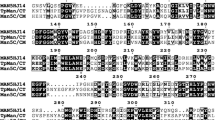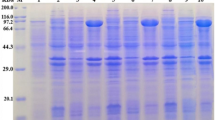Abstract
The formation of noncovalent complexes between glycosidase, endo-1,4-β-d-mannanase, and ionic surfactant di(2-ethylhexyl) sodium sulfosuccinate (AOT) was shown to promote protein transfer into organic solvents such as xylene and hexane. It was found that mannanase can be solubilized in hexane and in xylene with concentration at least 2.5 and 2.0 mg/ml, respectively. The catalytic activity of the enzyme in hexane spontaneously increases with the concentration of AOT and is about 10% of the activity in aqueous system. In xylene, a catalytic activity higher than that in bulk aqueous conditions was found for the samples containing 0.1–0.3 mg/ml of mannanase, while for the samples with a higher concentration of enzyme, the activity was hardly detected.


Similar content being viewed by others
References
Marques, S., Pala, H., Alves, L., Amaral-Collaco, M. T., Gama, F. M., & Girio, F. M. (2003). Characterisation and application of glycanases secreted by Aspergillus terreus CCMI 498 and Trichoderma viride CCMI 84 for enzymatic deinking of mixed office wastepaper. Journal of Biotechnology, 100, 209–219. doi:10.1016/S0168-1656(02)00247-X.
Sachslehner, A., Foidl, G., Foidl, N., Gubitz, G., & Haltrich, D. (2000). Hydrolysis of isolated coffee mannan and coffee extract by mannanases of Sclerotium rolfsii. Journal of Biotechnology, 80, 127–134. doi:10.1016/S0168-1656(00)00253-4.
Dhawan, S., & Kaur, J. (2007). Microbial mannanases: An overview of production and applications. Critical Reviews in Biotechnology, 27, 197–216. doi:10.1080/07388550701775919.
Moreira, L. R., & Filho, E. X. (2008). An overview of mannan structure and mannan-degrading enzyme systems. Applied Microbiology and Biotechnology, 79, 165–178. doi:10.1007/s00253-008-1423-4.
Leroy, C., Delbarre, C., Ghillebaert, F., Compere, C., & Combes, D. (2008). Effects of commercial enzymes on the adhesion of a marine biofilm-forming bacterium. Biofouling, 24, 11–22. doi:10.1080/08927010701784912.
Loiselle, M., & Anderson, K. W. (2003). The use of cellulase in inhibiting biofilm formation from organisms commonly found on medical implants. Biofouling, 19, 77–85. doi:10.1080/0892701021000030142.
Pettitt, M. E., Henry, S. L., Callow, M. E., Callow, J. A., & Clare, A. S. (2004). Activity of commercial enzymes on settlement and adhesion of cypris larvae of the barnacle Balanus amphitrite, spores of the green alga Ulva linza, and the diatom Navicula perminuta. Biofouling, 20, 299–311. doi:10.1080/08927010400027068.
Kristensen, J. B., Meyer, R. L., Laursen, B. S., Shipovskov, S., Besenbacher, F., & Poulsen, C. H. (2008). Antifouling enzymes and the biochemistry of marine settlement. Biotechnology Advances, 26, 471–481. doi:10.1016/j.biotechadv.2008.05.005.
Yebra, D. M., Kiil, S., & Dam-Johansen, K. (2004). Antifouling technology—past, present and future steps towards efficient and environmentally friendly antifouling coatings. Progress in Organic Coatings, 50, 75–104. doi:10.1016/j.porgcoat.2003.06.001.
Ballesteros, A., Bornscheuer, U., Capewell, A., Combes, D., Condoret, J. S., Koenig, K., et al. (1995). Enzymes in non-conventional phases. Biocatalysis and Biotransformation, 13, 1–42. doi:10.3109/10242429509040103.
Sheldon, R.A. (2008). E factors, green chemistry and catalysis: an odyssey. Chemical Communications (Cambridge), 3352–3365. doi:10.1039/b803584a
Madamwar, D., & Thakar, A. (2004). Entrapment of enzyme in water-restricted microenvironment for enzyme-mediated catalysis under microemulsion-based organogels. Applied Biochemistry and Biotechnology, 118, 361–369. doi:10.1385/ABAB:118:1-3:361.
Martinek, K., Levashov, A. V., Khmelnitsky, Y. L., Klyachko, N. L., & Berezin, I. V. (1982). Colloidal solution of water in organic solvents: A microheterogeneous medium for enzymatic reactions. Science, 218, 889–891. doi:10.1126/science.6753152.
Martinek, K., Levashov, A. V., Klyachko, N., Khmelnitski, Y. L., & Berezin, I. V. (1986). Micellar enzymology. European Journal of Biochemistry, 155, 453–468. doi:10.1111/j.1432-1033.1986.tb09512.x.
Shipovskov, S., Ferapontova, E., Ruzgas, T., & Levashov, A. (2003). Stabilisation of tyrosinase by reversed micelles for bioelectrocatalysis in dry organic media. Biochimica et Biophysica Acta, 1620, 119–124.
Shipovskov, S., & Levashov, A. (2004). Entrapping of tyrosinase in a system of reverse micelles. Biocatalysis and Biotransformation, 22, 57–60. doi:10.1080/1024242310001634755.
Tonova, K., & Lazarova, Z. (2008). Reversed micelle solvents as tools of enzyme purification and enzyme-catalyzed conversion. Biotechnology Advances, 26, 516–532. doi:10.1016/j.biotechadv.2008.06.002.
Paradkar, V. M., & Dordick, J. S. (1994). Mechanism of extraction of chymotrypsin into isooctane at very low concentrations of aerosol OT in the absence of reversed micelles. Biotechnology and Bioengineering, 43, 529–540. doi:10.1002/bit.260430614.
Paradkar, V. M., & Dordick, J. S. (1997). Aqueous-like activity of alpha-chymotrypsin dissolved in nearly anhydrous organic solvents. Journal of the American Chemical Society, 116, 5009–5010. doi:10.1021/ja00090a065.
Shipovskov, S. (2008). Homogeneous esterification by lipase from B. cepacia in the fluorinated solvent. Biotechnology Progress, 24, 1262–1266. doi:10.1002/btpr.37.
Akbar, U., Aschenbrenner, C. D., Harper, M. R., Johnson, H. R., Dordick, J. S., & Clark, D. S. (2007). Direct solubilization of enzyme aggregates with enhanced activity in nonaqueous media. Biotechnology and Bioengineering, 96, 1030–1039. doi:10.1002/bit.21291.
Stålbrand, H., Siikaaho, M., Tenkanen, M., & Viikari, L. (1993). Purification and characterization of two beta-mannanases from Trichoderma reesei. Journal of Biotechnology, 29, 229–242. doi:10.1016/0168-1656(93)90055-R.
Bradford, M. M. (1976). A rapid and sensitive method for the quantitation of microgram quantities of protein utilizing the principle of protein-dye binding. Analytical Biochemistry, 72, 248–254. doi:10.1016/0003-2697(76)90527-3.
Ekwall, P., Mandell, L., & Fontell, K. (1970). Some observation on binary and ternary aerosol OT systems. Journal of Colloid and Interface Science, 33, 215–235. doi:10.1016/0021-9797(70)90024-X.
Tamamushi, B., & Watanabe, N. (1980). The formation of molecular aggregation structures in ternary system: Aerosol OT/water/iso-octane. Colloid & Polymer Science, 258, 174–178. doi:10.1007/BF01498277.
Acknowledgments
This work was funded by the Danish National Advanced Technology Foundation through the ProSURF platform (Protein-Based Functionalization of Surfaces). SS thanks Elin Ellebaek Petersen and Masoud Zargahi (Genencor, Danisco A/S) for support and fruitful discussions.
Author information
Authors and Affiliations
Corresponding author
Rights and permissions
About this article
Cite this article
Shipovskov, S., Kragh, K.M., Laursen, B.S. et al. Mannanase Transfer into Hexane and Xylene by Liquid–Liquid Extraction. Appl Biochem Biotechnol 160, 1124–1129 (2010). https://doi.org/10.1007/s12010-009-8661-5
Received:
Accepted:
Published:
Issue Date:
DOI: https://doi.org/10.1007/s12010-009-8661-5




